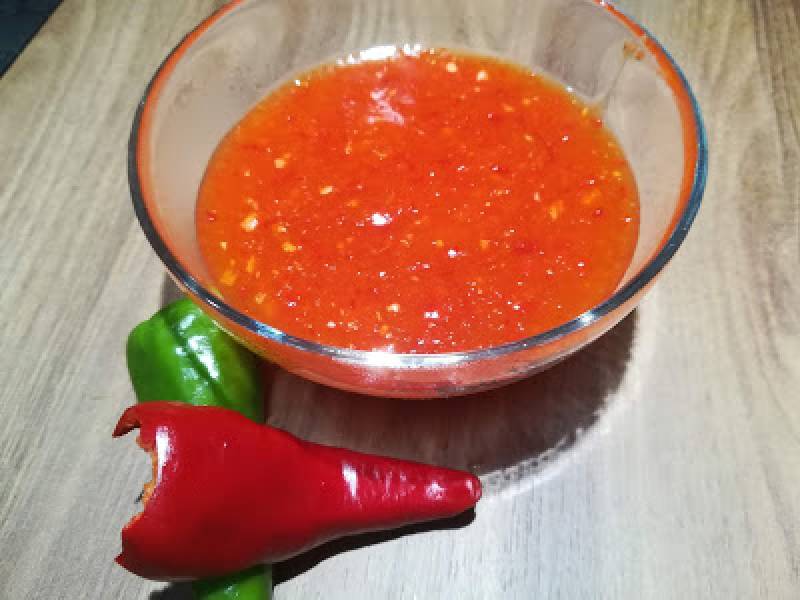Chili sauce is a common condiment in Asian cuisine and is widely used in various dishes to add flavor and heat. Asian chili sauces come in different varieties and can range from mild to extremely spicy. These sauces are made from a variety of chili peppers, mixed with other ingredients such as vinegar, garlic, sugar, and salt, to create a balance of flavors.
One popular type of Asian chili sauce is Sriracha, which originated in Thailand but has gained worldwide popularity. Sriracha sauce is made from sun-ripened chili peppers, vinegar, garlic, sugar, and salt. It has a tangy and slightly sweet flavor with a moderate level of heat. Sriracha sauce is often used as a dipping sauce for spring rolls, dumplings, and fried foods, as well as a condiment for stir-fries and noodle dishes.
Another well-known Asian chili sauce is Sambal, which originates from Indonesia and Malaysia. Sambal is made primarily from chili peppers, along with other ingredients such as shrimp paste, garlic, ginger, and lime juice. It is typically spicier than Sriracha and has a rich, complex flavor profile. Sambal is commonly used as a sauce for rice dishes, grilled meats, and seafood.
In Chinese cuisine, chili sauce is often referred to as “la jiao jiang” and is made from chili peppers, garlic, vinegar, and soy sauce. Chinese chili sauce can vary in spiciness, with some brands offering mild versions and others offering extra hot varieties. It is used in a wide range of Chinese dishes, including stir-fries, hot pot, and noodle soups.
Korean cuisine is also renowned for its chili-based sauces, with the most well-known being Gochujang. Gochujang is a fermented chili paste made from chili peppers, glutinous rice, fermented soybeans, and salt. It has a deep, savory flavor with a moderate level of heat. Gochujang is a staple in Korean cooking and is used in dishes such as bibimbap, bulgogi, and tteokbokki.
Beyond these specific types, there are countless other chili sauces and pastes used in different Asian cuisines. These include chili oils, which are made by infusing chili peppers into oil, and chili pastes, which are made from ground chili peppers mixed with various ingredients. Each region and country in Asia has its own unique variations and recipes for chili sauce, resulting in a diverse range of flavors and spiciness levels.

Asian chili sauces have gained popularity around the world due to the growing interest in Asian cuisine and the desire for bold and spicy flavors. Many restaurants and food manufacturers now offer Asian-inspired sauces and condiments to cater to this demand. Additionally, homemade chili sauces have become increasingly popular, with recipes shared online and in cookbooks, allowing people to experiment with different ingredients and flavors.
In conclusion, chili sauce is a versatile and widely used condiment in Asian cuisine. From the tangy and moderately spicy Sriracha sauce to the fiery and complex Sambal, Asian chili sauces add depth of flavor and heat to various dishes. With the diverse range of chili sauces available, there is a perfect sauce to suit every taste and level of spiciness preference.Asian Chili Sauces: A Hot Opportunity in the Condiment Market
Introduction:
The global condiment market continues to grow, fueled by consumers’ desire for unique flavors and a preference for spicy foods. Within this market, Asian chili sauces have gained significant popularity, offering a range of bold and fiery flavors. This article explores the business potential of Asian chili sauces, discussing their market growth, key players, consumer trends, and opportunities for entrepreneurs and existing businesses to capitalize on the rising demand for these flavorful condiments.
1. Market Growth and Demand:
The market for chili sauces, particularly Asian varieties, has witnessed robust growth in recent years. A growing interest in international cuisines and the popularity of Asian dishes have contributed to the increased demand for Asian chili sauces worldwide. According to Research Reports World, the global chili sauce market is projected to grow at a CAGR of 5.94% from 2021 to 2026, reaching a value of $5.26 billion by the end of the forecast period.
2. Key Players:
Several prominent players dominate the Asian chili sauce market. Huy Fong Foods, the manufacturer of the iconic Sriracha sauce, is one of the leading brands globally. Other notable players include Lee Kum Kee, ABC Sambal, Pantai Norasingh, and Ajumma Republic. These companies offer a wide range of chili sauces catering to different taste preferences and levels of spiciness.

3. Consumer Trends:
The rising popularity of Asian chili sauces can be attributed to evolving consumer trends. Firstly, consumers are increasingly seeking unique and adventurous flavors, and Asian chili sauces provide an excellent way to introduce spicy and robust tastes to their meals. Secondly, there is growing awareness of the health benefits of chili peppers, such as their potential to boost metabolism and aid digestion, further driving the demand for chili sauces.
4. Culinary Diversity and Adaptability:
Asian chili sauces offer a wide range of flavors and spice levels, catering to diverse culinary preferences. From the tangy sweetness of Thai Sriracha to the savory spiciness of Indonesian Sambal, these sauces can enhance the taste of various dishes, including noodles, rice, stir-fries, grilled meats, seafood, and even snacks like spring rolls and dumplings. Their versatility and ability to enhance the flavor profile of different cuisines make Asian chili sauces a valuable addition to any kitchen.
5. Health-Conscious Consumers:
In addition to adding flavor, Asian chili sauces can offer health benefits to consumers. Chili peppers contain capsaicin, a compound known for its antioxidant and anti-inflammatory properties. The consumption of capsaicin can also stimulate the release of endorphins and boost mood. As consumers seek healthier food options, chili sauces can serve as a natural and flavorful alternative to artificial additives commonly found in processed condiments.
6. Rising Popularity of Ethnic Foods:
The growing popularity of Asian cuisines and the increasing number of Asian restaurants and food trucks have fueled the demand for authentic Asian chili sauces. Consumers are becoming more adventurous in their culinary explorations, and Asian chili sauces add an element of authenticity to their homemade dishes. Entrepreneurs in the condiment industry can tap into this trend by offering high-quality, artisanal Asian chili sauces to meet the demand of consumers seeking unique and authentic flavors.

7. Opportunity for New Product Development:
The Asian chili sauce market offers substantial opportunities for entrepreneurs and existing businesses to innovate and develop new product offerings. With a vast range of chili peppers and ingredients available, manufacturers can experiment with different flavors, spice levels, and ingredients to create novel and gourmet chili sauces. Expanding the product line with limited-edition or seasonal variations can also attract consumers looking for exclusivity and flavor diversity.
8. Foodservice Industry Integration:
The foodservice industry presents an untapped market for Asian chili sauce manufacturers. Restaurants, cafes, and other food establishments can benefit from incorporating Asian chili sauces into their menus, offering customers the opportunity to customize their dishes with spicy and flavorful condiments. Collaborations between chili sauce manufacturers and foodservice providers can create mutually beneficial partnerships that elevate the dining experience and drive sales for both parties.
9. Online and E-Commerce Opportunities:
The rise of e-commerce platforms and online grocery shopping has created new avenues for Asian chili sauce manufacturers to reach consumers. Establishing an online presence through websites and partnerships with online retailers allows manufacturers to expand their customer base beyond their traditional markets. Furthermore, leveraging social media platforms can help create awareness, engage with customers, and generate buzz around new product launches and promotions.
10. Sustainability and Ethical Sourcing:
As consumers increasingly prioritize sustainability and ethical practices, there is a growing demand for chili sauces made from responsibly sourced ingredients. Companies that focus on fair trade, organic farming, and supporting local farmers can attract conscious consumers who value transparency and ethical production practices. Emphasizing these values in marketing campaigns and packaging can differentiate a brand and establish a loyal customer base.

Conclusion:
The market for Asian chili sauces is abound with opportunities for entrepreneurs and existing businesses in the condiment industry. With a growing demand for bold and spicy flavors, these sauces can cater to consumers’ desire for culinary exploration and uniqueness. By understanding consumer trends, leveraging online platforms, and emphasizing sustainability, businesses can thrive in this dynamic market. As the love for Asian cuisine continues to grow, the appetite for Asian chili sauces shows no signs of cooling down.









